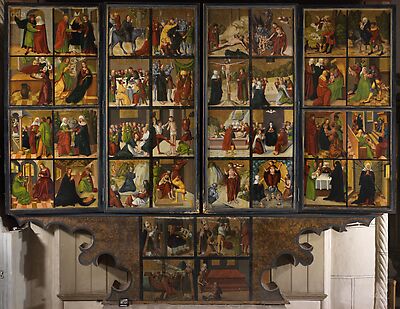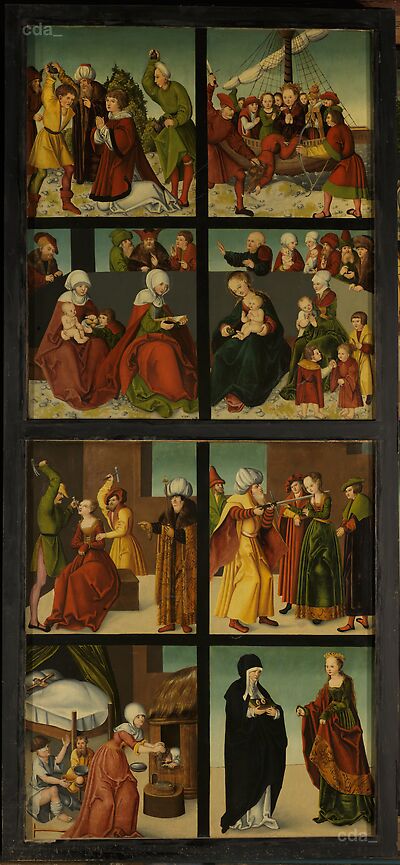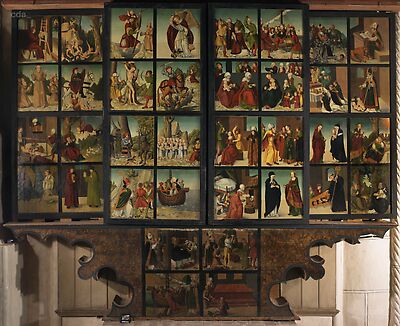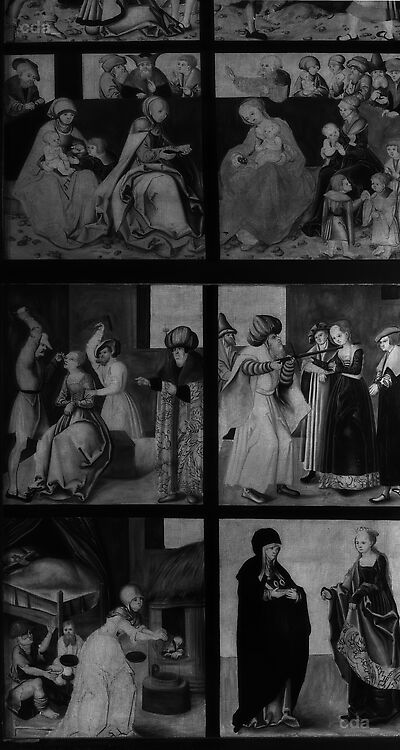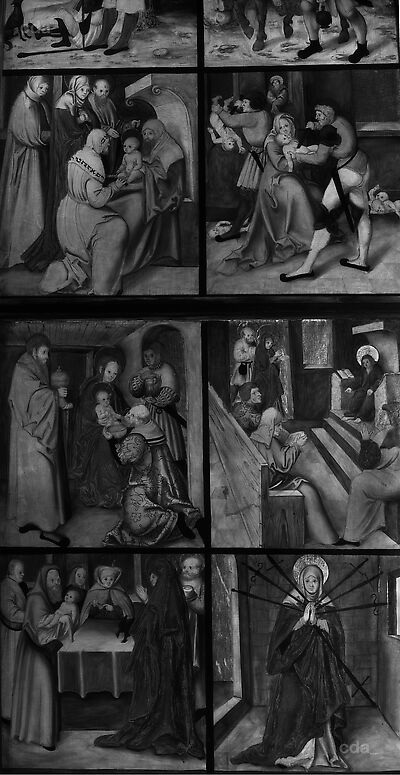Annunciation to the Shepherds (an infrared reflectogram in not available)
The Circumcision and Naming of Jesus
DESCRIPTION
Tools/Material:
- fluid, black medium, brush
Type/Ductus:
- relatively detailed and freehand underdrawing after a pre-existing design
- thin lines
- occasional hatching strokes
Function:
- binding for the final painted version; the lines define the main contours and describe essential details and facial features; occasional representation of volume with hatching strokes
Deviations:
- minor corrections were made to forms during the painting process
INTERPRETATION
Attribution:
- not possible (not Cranach workshop)
The Adoration of the Magi
DESCRIPTION
Tools/Material:
- fluid, black medium, brush
Type/Ductus:
- relatively detailed and freehand underdrawing after a pre-existing design
- thin lines
Function:
- relatively binding for the final painted version; the lines define the main contours and describe essential details and facial features; no representation of volume with hatching strokes
Deviations:
- minor corrections were made to forms during the painting process; small changes (e. g. the older king’s feet)
INTERPRETATION
Attribution:
- not possible (not Cranach workshop)
Presentation in the Temple
DESCRIPTION
Tools/Material:
- black medium, brush
Type/Ductus:
- relatively detailed and freehand underdrawing after a pre-existing design
- thin lines
Function:
- relatively binding for the final painted version; the lines define the main contours and describe the essential details and facial features; no representation of volume with hatching strokes
Deviations:
- almost no corrections were made to forms during the painting process; small changes (e. g. the face of the woman behind the infant Christ)
INTERPRETATION
Attribution:
- not possible (not Cranach workshop)
Flight into Egypt (an infrared reflectogram is not available)
The Massacre of the Innocent
DESCRIPTION
Tools/Material:
- fluid medium, brush; in two phases with different inks
Type/Ductus:
- freehand underdrawing after a pre-existing design
- thin lines
- occasional hatching strokes
Function:
- binding to relatively binding for the final painted version; the lines define the main contours and describe essential details and facial features; occasional representation of volume with hatching strokes
Deviations:
- minor corrections were made to forms during the painting process; small changes (e. g. the feet in the foreground)
INTERPRETATION
Attribution:
- not possible (not Cranach workshop)
Jesus as Twelve Year Old in the Temple
DESCRIPTION
Tools/Material:
- fluid medium, brush
Type/Ductus:
- freehand underdrawing after a pre-existing design
- thin lines, occasionally broader
- construction lines
Function:
- binding to relatively binding for the final painted version; the lines define the main contours and describe essential details and facial features; no representation of volume with hatching strokes
Deviations:
- minor corrections were made to forms during the painting process, small changes
INTERPRETATION
Attribution:
- not possible (not Cranach workshop)
The Virgin as Mother of Sorrows
DESCRIPTION
Tools/Material:
- fluid medium, brush
Type/Ductus:
- freehand underdrawing after a pre-existing design
- thin lines, occasionally broader
- construction lines
Function:
- occasionally only relatively binding for the final painted version; the lines define the main contours and describe essential details and facial features; no representation of volume with hatching strokes
Deviations:
- corrections were made to forms during the painting process; changes (e. g. the swords)
INTERPRETATION
Attribution:
- not possible (not Cranach workshop)
Verso:
The Stoning of St Stephen (an infrared reflectoggram is not available)
The Holy Kinship (across two fields)
DESCRIPTION
Tools/Material:
- an initial design was executed with a dry drawing material, stylus; and then combined with a fluid, black medium, brush
ype/Ductus:
- relatively detailed and freehand underdrawing after a pre-existing design
- delicate (stylus) and thin lines
Function:
- binding for the final painted version; the lines define the main contours and describe essential details and facial features; occasional representation of volume with hatching strokes
Deviations:
- minor corrections were made to forms during the painting process; small changes
INTERPRETATION
Attribution:
- not possible (not Cranach workshop)
The Martyrdom of St Apollonia
DESCRIPTION
An underdrawing is not readily visible, but probably:
Tools/Material:
- dry drawing material, stylus
Type/Ductus:
- freehand underdrawing after a pre-existing design
- delicate lines (where visible)
Function:
- binding for the final painted version; the lines define the main contours and describe essential details and facial features; no representation of volume with hatching strokes
Deviations:
- no corrections were made to forms during the painting process
INTERPRETATION
Attribution:
- not possible (not Cranach workshop)
St Hedwig
DESCRIPTION
- an underdrawing is not readily visible
INTERPRETATION
Attribution:
- not possible (not Cranach workshop)
The Pilgrimage of St Ursula (an infrared reflectogram is not available)
The Martyrdom of St Lucy
DESCRIPTION
Tools/Material:
- fluid medium, brush
Type/Ductus:
- freehand underdrawing after a pre-existing design
- thin lines
Function:
- binding to relatively binding for the final painted version; the lines define the main contours and describe essential details and facial features; no representation of volumes with hatching strokes
Deviations:
- minor corrections were made to forms during the painting process; small changes
INTERPRETATION
Attribution:
- not possible (not Cranach workshop)
St Odilia
DESCRIPTION
Tools/Material:
- fluid medium, brush (?)
Type/Ductus:
- freehand underdrawing after a pre-existing design
- thin lines
Function:
- binding fort he final painted version; only occasionally visible; no representation of volume with hatching strokes
Deviations:
- minor corrections were made to forms during the painting process; small changes
INTERPRETATION
Attribution:
- not possible (not Cranach workshop)
[Sandner, Heydenreich, Smith-Contini, cda 2017]
![The Bernau Altarpiece [right alteration wing]: The childhood of Christ [recto], Live of Saints [verso]](https://lucascranach.org/imageserver-2022/DE_StMB_NONE-001d_FR-none/01_Overall/DE_StMB_NONE-001d_FR-none_2016-02_Overall-s.jpg)
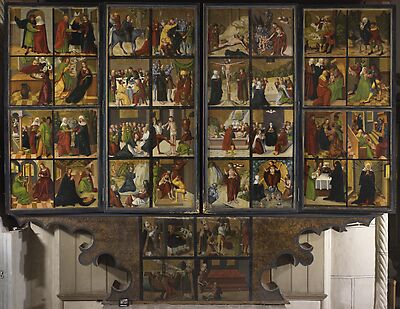
![The Bernau Altarpiece [left alteration wing]: Live of the Virgin [recto], Live of Saints [verso]](https://lucascranach.org/imageserver-2022/DE_StMB_NONE-001c_FR-none/01_Overall/DE_StMB_NONE-001c_FR-none_2016-02_Overall-s.jpg)
![The Bernau Altarpiece [left side wing]: The Golden Legend (Aurea Legenda)](https://lucascranach.org/imageserver-2022/DE_StMB_NONE-001e_FR-none/01_Overall/DE_StMB_NONE-001e_FR-none_2016-02_Overall-s.jpg)
![The Bernau Altarpiece [right side wing]: The Golden Legend (Aurea Legenda)](https://lucascranach.org/imageserver-2022/DE_StMB_NONE-001f_FR-none/01_Overall/DE_StMB_NONE-001f_FR-none_2016-02_Overall-s.jpg)
![The Bernau Altarpiece [predella]: St Nicholas legend](https://lucascranach.org/imageserver-2022/DE_StMB_NONE-001g_FR-none/01_Overall/DE_StMB_NONE-001g_FR-none_2016-02_Overall-s.jpg)
![The Bernau Altarpiece [left inner wing]: Passion of Christ [verso]](https://lucascranach.org/imageserver-2022/DE_StMB_NONE-001a_FR-none/01_Overall/DE_StMB_NONE-001a_FR-none_2016-02_Overall-s.jpg)
![The Bernau Altarpiece [right inner wing]: Passion of Christ [verso]](https://lucascranach.org/imageserver-2022/DE_StMB_NONE-001b_FR-none/01_Overall/DE_StMB_NONE-001b_FR-none_2016-02_Overall-s.jpg)
